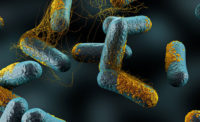Regulatory agencies and public-health authorities have increasingly used whole genome sequencing (WGS), a laboratory process that can determine the DNA sequence of microorganisms, as part of pathogen surveillance programs and foodborne outbreak investigations. In recent meetings with industry, the Food Safety and Inspection Service (FSIS) has been sharing how the agency will continue to use WGS to help meet its public health mission.
One critical component of the agency’s 2017-2021 Strategic Plan is modernization, which among other initiatives, includes WGS. The agency is making the capital investment in WGS and the necessary personnel expertise to build its infrastructure capacity, so the nearly 10,000 isolates FSIS collects yearly can be sequenced by 2018. This is critical, as FSIS has indicated it intends to rely less on non-WGS techniques for pathogen surveillance and outbreak investigations in the next decade. That means the agency will become less dependent on culture enrichments and begin consolidating its various techniques for bacterial characterization to a single workflow. In other words, the data collected by serotyping, PFGE (pulsed field gel electrophoresis), and any of FSIS’s antimicrobial susceptibility testing will eventually be replaced by WGS. But the agency has confirmed epidemiological data will always be considered in conjunction with WGS analysis when it comes to outbreak investigations.
The agency is also exploring how WGS may be used in the field to assist with regulatory and public health real-time decision making. The agency already uses WGS data, with PFGE and epidemiology information, when collaborating with other public health and regulatory agencies in foodborne outbreak investigations. FSIS also uses the technology to better understand potential harborage or recurrence of Lm contamination in meat and poultry establishments. The agency is examining fit-for-purpose detection systems and employing various pilot-programs to determine how the technology can be scaled up to make real-time decisions in such investigations.
FSIS, with the Food and Drug Administration (FDA) and Centers for Disease Control and Prevention (CDC), submit its food, environment and human clinical data to the GenomeTrakr Network, which is a network of laboratories that utilize WGS for foodborne pathogen identification. GenomeTrakr data is housed in public databases at the National Institutes of Health’s National Center for Biotechnology (NCBI), which allows for the genomic data to be collected and shared for use. The sharing of foodborne WGS data occurs not only among U.S. agencies but with domestic and global collaborators as well. More than 61,000 sequenced isolates have been uploaded to GenomeTrakr since February 2013, with approximately 1,000 isolates being sequenced per month. GenomeTrakr collaborators are not limited to those in the U.S., but laboratories in Argentina, Austria, Australia, Canada, Denmark, Germany, Ireland, Italy and the United Kingdom also upload foodborne isolate data. Using GenomeTrakr, FSIS can compare every isolate it uploads with all the other isolates in the database to see if there are any matches. As of August, the agency had sequenced and uploaded more than 4,400 isolates to NCBI.
In addition, multiple interagency collaborations are ongoing as it relates to WGS. FSIS, FDA, CDC and NCBI have established an interagency workgroup called Gen-FS. The intent of Gen-FS is to harmonize efforts among the agencies on how WGS is implemented for food safety purposes. FSIS is also collaborating with FDA on a project to sequence all human, food and environment Lm samples in real-time. More than 500 FSIS Lm samples have been uploaded since August 2013. FSIS also works with its partners within the National Antimicrobial Resistance Monitoring System to use WGS to better understand how antimicrobial resistance genes are introduced and operate within pathogens.
WGS is not a new technology per se, as molecular typing in one form or another has been around for more than 20 years. What differentiates WGS from other molecular typing techniques such as PFGE is the specificity of data generated. This specificity will allow the agency to better determine whether illnesses and products are linked in foodborne outbreaks as well as whether contamination events in establishments represent ongoing issues. It also brings unique challenges that will need to be addressed as WGS is used to inform public health and regulatory initiatives. NP





Report Abusive Comment